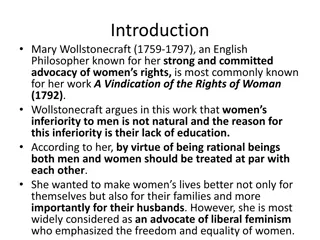
Women's Rights Movements in China and America: A Comparison
Women's rights movements in both China and America have seen significant developments over the centuries. While traditional Chinese society held women in a subordinate position, American feminism has strived for equality on all fronts. Explore the historical context, challenges, and progress made in both countries regarding women's rights, from ancient China to the modern-day United States.
Download Presentation

Please find below an Image/Link to download the presentation.
The content on the website is provided AS IS for your information and personal use only. It may not be sold, licensed, or shared on other websites without obtaining consent from the author. If you encounter any issues during the download, it is possible that the publisher has removed the file from their server.
You are allowed to download the files provided on this website for personal or commercial use, subject to the condition that they are used lawfully. All files are the property of their respective owners.
The content on the website is provided AS IS for your information and personal use only. It may not be sold, licensed, or shared on other websites without obtaining consent from the author.
E N D
Presentation Transcript
Bridge 4 Woman s Bondage in China Gloria
Womens right in America Feminism in the United States refers to the collection of movements and ideologies aimed at defining, establishing, and defending a state of equal political, economic, cultural, and social rights for women in the United States. Feminism has had a massive influence on American politics. According to the 2017 Gender Gap Index measurement of countries by the World Economic Forum, the United States is ranked 49th on gender equality
Womens right in China before 1900 Prior to the 20th century, women in China were considered essentially different from men. Despite the association of women with yin and men with yang, two qualities considered equally important by Daoism, women were believed to occupy a lower position than men in the hierarchical order of the universe. The I Ching stated that "'Great Righteousness is shown in that man and woman occupy their correct places; the relative positions of Heaven and Earth.' Women were to be submissive and obedient to men, and normally not allowed to participate in government, military or community institutions. While there were lauded exceptions in Chinese history and literature, such as the Song dynasty general Liang Hongyu and legendary woman warrior Hua Mulan, these were considered to be signs of the dire situation of China at the time. Before the 20th century, such exceptional women were believed to have fought to defend China's traditional patriarchal order and society, not to change it.
Womens right in China in 20th century A number of women, and some men, started to speak out against these conditions in the late 19th and early 20th centuries, but to little avail. Nevertheless, the fact that they had fought alongside men encouraged many of the women who had taken part in the women militias to become politically active, striving for change.
Womens right in China in 21th century In 2019, a government directive was released banning employers in China from posting "men preferred" or "men only" job advertising, and banning companies from asking women seeking jobs about their childbearing and marriage plans or requiring applicants to take pregnancy tests.
Dong MingZhu Current chairman and President of Gree Electric Appliances,Inc. Of Zhuhai
Sun YaFang Ranked second in the 2017 list of China's most outstanding businesswomen Director, huawei technologies co. LTD
Peng Lei One of the 18 founders and partners of alibaba, he was vice President of marketing and service department, chief human resources officer and chairman of ant financial services group
Wu Yi Former vice premier, former member of the politburo, known as "China's iron lady", never married
Song MeiLin First lady of Asia
Wu Zetian First women emperor in China
Artist Statement For this bridge 4 s project, I m doing a project about the bondage of women in China. As we currently stay in the America, we have a lot of freedom to speak up. But in China, it s even for us to hold a protest. Why I choose the bondage of women in China as my bridge 4 s project is I want to show that women is not worse than men. Women can also do a lot of remarkable things as a men can be, or even more successful than a man. I choose to do a collage about women and the tile the RMB and some of the most successful women in China because I think it is a good example to put RMB and women together. RMB is the most common used things in China. I want the women can also be the most proud things when people is talking.






















